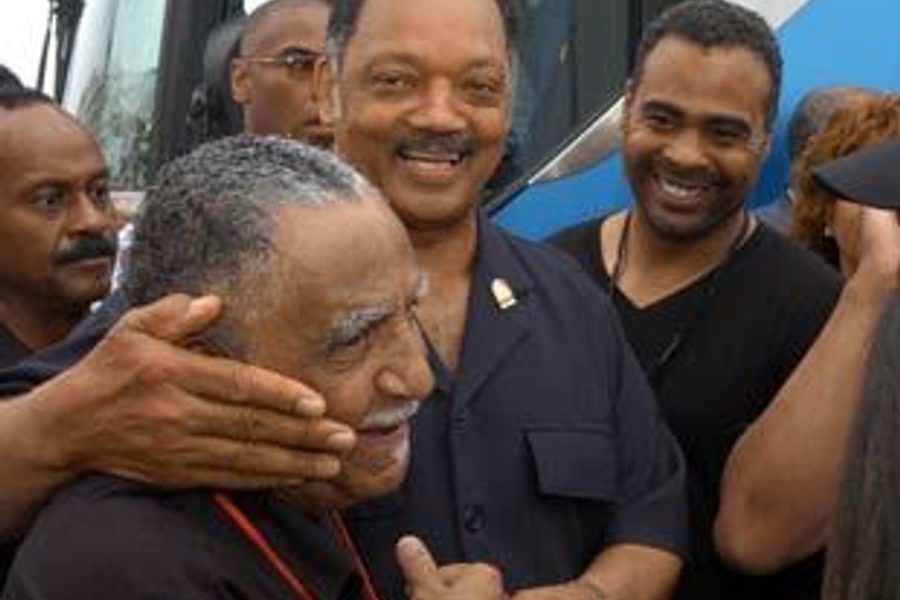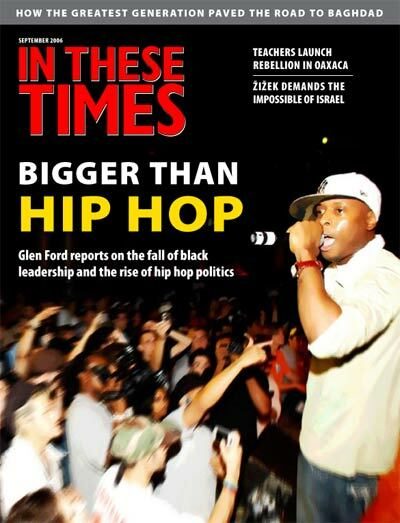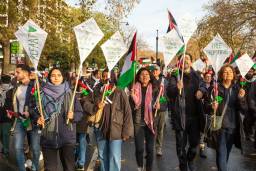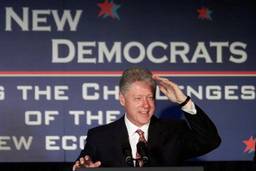“It’s bigger!” roared T.J. Crawford. “It’s bigger!” the crowd shouted back, in traditional call-and-response fashion. “It’s bigger than hip hop!”
Crawford, chairman of the National Hip Hop Political Convention (NHHPC), deployed the hook of a song by hip hop’s iconic “conscious” group, dead prez, to bring home the point: Members of what marketers have labeled the “hip-hop generation” are concerned with much more than just nodding their heads to the beat. Politics is more important – bigger! – than music for activists who have felt swept aside and demobilized by black elders whose outlook was forged in the crucible of civil rights organizing. These young crews, along with the elders who hang with them on political issues, aim to seize leadership of what’s left of the movement – although they’re not quite sure how to do it.
Hip-hop politics emerged from the musical movement launched in the South Bronx in the late ’70s – itself a reaction to the unfinished business, the arrested development, of black politics. The late-’60s demise of segregation allowed black professionals to escape the inner city, to climb corporate ladders and achieve elected offices. However, budding corporate executives and elected officials have little use for mass movements, except on election days or when corporate careers are threatened by institutional racism. As a class, these “New Negroes” left the rest of the African American population still locked in the ghetto, to their own devices.
“The birth of hip hop, the environment, grew out of the early ’70s, police brutality, poverty, unemployment – all these social ills that were affecting marginalized and oppressed people,” says Angelica Salazar, an ethnic studies major at University of California, Berkeley, and an activist in the Coalition for Black-Brown Unity and the NHHPC movement. “One of the reasons that hip hop has been so globally successful – so critical in reaching our people and crossing borders – is that every marginalized people who have been oppressed and put into ‘reservations’ can relate to that experience. You are trying to recreate what was stolen from you.”
Looking to put black politics back on track, 4,000 people from across the nation, mostly but not entirely African American, flocked to multiple venues on Chicago’s South Side for the convention. They hoped to build on the work of the first NHHPC, which took place in Newark, New Jersey in 2004.
The Chicago affair, like its Newark predecessor, strained to tackle the two fundamental questions that are constantly posed to younger blacks: Is there a generational divide among African American activists, or are the fissures more complicated? And how can the cultural force of hip hop be directed to affect social change?
The old school
Despite the gains that African Americans have made since segregation, social change is still very much needed. But a mass black movement has floundered. According to NAACP chairman Julian Bond, there were 10,000 separate anti-racist actions in the year 1963 alone. In the current era, one is hard-pressed to name a significant anti-racist demonstration in any given year.
While the older generation of civil rights activists is marching on, they’re no longer at the front of the action. Last year, 20,000 braved Atlanta’s August heat to demand reauthorization of the Voting Rights Act in a march organized by the NAACP, the Southern Christian Leadership Conference, Rainbow/PUSH Coalition, black churches and civic groups, and a strong union contingent. But considerably less than half the participants could reasonably be called youthful. “It was a significantly older crowd,” says Bruce Dixon, Atlanta-based editor of BlackCommentator.com (of which I am executive editor) and longtime activist. “Back in the days when a real movement existed, the crowd would have been nine-tenths youth.”
On the speakers’ platform, among a cast that included Rev. Jesse Jackson, Harry Belafonte, and U.S. Reps. John Lewis (D-Ga.) and Maxine Waters (D-Calif.), the youngest notables were singer Stevie Wonder, age 55, and TV’s Judge Greg Mathis, 45.
Similar demographics dominated the throng that attended the Millions More rally on Washington’s Capitol Mall in October 2005. The seemingly endless list of speakers, although representing virtually every political tendency in Black America, included very few below age 50 – and these tended to be entertainers. Despite the presence of a vocal Howard University contingent, the atmosphere was more picnic-like than militant – a Saturday gathering of mainly middle-aged folks.
Clearly, black movement politics has entered the geriatric stage – if, indeed, anything worthy of the term “movement” still exists.
The NAACP’s youth and college councils number about 100,000 people – one-fifth of the claimed half-million overall membership of the only real mass organization in Black America. The Southern Christian Leadership Conference is no longer a mass organization, and has nothing like the Student Nonviolent Coordinating Committee (defunct since 1970) under its umbrella. The National Urban League has never been a mass grouping. Operation PUSH/Rainbow Coalition is Rev. Jackson’s vehicle, and functions as he wishes. PUSH has not developed an independent youth group, or anything else independent of Rev. Jackson.
All too often, critics dismiss the lack of younger activists at the podium as a function of a black “generational divide.” Could it be that simple?
Divided we fall
Not according to Rev. Lennox Yearwood, the 36-year-old head of the D.C.-based Hip Hop Caucus. Instead of a generational schism, he sees a “cultural and geographic divide” that developed after the death of Jim Crow provided an opening for spatial and economic mobility to those blacks positioned to take advantage of it.
Traditional black organizations were most concerned with servicing the goals of these aspiring populations, according to Rev. Yearwood. “The church and other institutions have gone from being usable institutions for the community to being institutionalized” – upholding rather that rattling the status quo. In contrast, he says, “Hip hop emerges out of the Black Power Movement, as a voice for the urban community.”
Yearwood has been involved in an extraordinary range of political activities under the hip-hop umbrella, from Russell Simmons’ Hip-Hop Summit Action Network to the AFL-CIO-affiliated Hip Hop Voices to Hip Hop U.N., “a coalition of all the hip-hop political organizations throughout the world.” His organization describes itself as “a national and international coalition of hip hop, pop-culture, social and political organizations, community-based organizations, youth leadership organizations, and individuals who believe in the collective power of persons born after 1964.”
In Jersey City, N.J., 25-year-old Hassan Salaam helps public school kids with their homework and teaches chess to youngsters through a National Urban League program. He’s also a hip-hop activist with the Grassroots Artist Movement, which secures healthcare services for artists. Salaam is confident that his cadre of artists is in tune with the black political/cultural continuum.
“There’s no difference to me,” says Salaam, who equates Grandmaster Flash’s classic “The Message” with the works of Duke Ellington and John Coltrane. “Within hip hop, we’re talking about the same things the older people talk about.”
“There is a generational divide, but it’s not the primary problem,” agrees Troy Nkrumah. A lawyer under 30, he assists political prisoners and radical youth organizations in Las Vegas, after doing similar work in the San Francisco Bay area. From Nkrumah’s perspective, it is the political timidity of established black leaders that has led to the current generational tensions. “The civil rights folks got into comfortable positions,” said Nkrumah. “In their minds, they thought they were still down with the movement, but they resisted the radicalism of the young.”
If the cutoff date for the hip-hop generation is a birthday in 1964, then a majority of black people now belong to it, Nkrumah told me. “Hip hop grows every year,” he continues. “Until it dies out, it will grow. Hip hop is not just music, dancing, graffiti – it’s activism.”
Angela Woodson, the 36-year-old co-chair of the Newark convention, presents a starker view of the youth cultural scene. “There are three worlds of hip hop. There’s the corporate world, the political world – and the stupid world.”
That “stupid world” grew out of the gangsta rap genre that corporate record labels have been pushing since the early ’90s. The corporatization and segmentation of black music has been crucial in driving a wedge between generations.
“Me and my parents listened to the same radio station: WBLS-FM – that was the campfire,” says New York native and Bay Area radio personality Davey D, who is not yet 40. “Now the same company uses one station to target one age group, another station to target the other. If you look at the types of venues where wisdom was dispersed, you don’t have elders talking to younger people.”
This generation lives in a different media world than their elders – one stripped of relevance. The content of corporate-owned stations is dumbed down and apolitical. During the mass demonstrations for immigrant rights in Los Angeles, KKBT-FM (“The Beat”) completely ignored one million people in the streets. “It was similar to the Million Man March right on their doorstep, yet to KKBT and its listeners, it didn’t exist,” says Davey D.
So, culture, class issues, consumerism and varying degrees of complacency all divide African Americans, as much if not more than generational differences.
In fact, to reduce the fragmentation of black politics into a generation gap is to play into the hands of the right. Republicans have shown that it can play the youth game as well as the left – better, because they have more money.
Take the victory of Newark’s new African-American mayor, Cory Booker, who was an obscure, 33-year-old, one-term Newark city councilman when he starred at a power luncheon at the Manhattan Institute, the right-wing outfit that specializes in media influence, in 2000. Booker had earlier hooked up with the Bradley and Walton Family (Wal-Mart) Foundations, to become a director of their political invention, the Black Alliance for Educational Options (BAEO) – a pro-school vouchers group. After losing the 2002 election, Booker raised $6.1 million for another run, garnering universal corporate media endorsements. He based his campaign on the need for “new blood” and criticisms of the “tired civil-rights generation.”
All together now
Seeking change, young and old came together at both the 2004 NHHPC and the one that took place this year in Chicago’s historic Bronzeville neighborhood.
The oldest speaker at the first day’s Intergenerational Dialogue, Illinois Secretary of Human Services Dr. Carol Adams, was possibly the most militant of “The Movement Continues” panel participants. “To think that we have to begin our revolution again every generation is sad, indeed,” said the sixtyish black civil servant. The crowd exploded in cheers.
NHHPC activists were quick to distinguish themselves from the rich entrepreneurs and poseurs who claim to be the voice of a younger generation.
“I don’t know that I need Fat Joe [an Afro-Puerto Rican/Bronx rapper] to be the next black leader, the next Malcolm X,” said Cedric Shine, a recent graduate from Temple University who works for the Center for American Progress, a liberal think tank in Washington, D.C. “I don’t think me and P-Diddy are going to have similar goals in life.”
Twenty-seven-year-old Adrienne Marie Brown was a key player in the 2004 NHHPC as well as an operative in that year’s Democratic election campaign. Brown trained voter organizations and created voter guides in Ohio, and also worked through the League of Pissed Off Voters, whose “mission is to engage pissed off 17 to 35-year-olds in the democratic process to build a progressive governing majority in our lifetime.”
Brown believes the younger black demographics are grouped in three political sections: youth activists in the civil rights movement, a hip-hop movement heavily influenced by “angry” black music, and the young middle class.
Young civil rights activists working in traditional organizations are blocked from taking power by an entrenched leadership, says Brown. The group she calls the “young middle class” are comfortable and complacent. “Most black middle-class young people – a huge arena – don’t identify as hip hop or as civil rights. They just want to boogie. They don’t want to mess anything up.” Black leadership, for this cohort, is whatever power and media say it is. “They look at black leadership and see people like Condoleezza Rice. We in the hip-hop movement don’t see Condoleezza Rice as evidence of progress,” Brown says.
Brown is now executive director of the Ruckus Society, which “provides environmental, human rights, and social justice organizers with the tools, training, and support needed to achieve their goals.” Her mission? To spark a mass movement.
Limitations in the movement
But can hip-hop politics provide a new way in the face of corporatization and complacency? Reviews are mixed.
Some were not happy with the organizers of this year’s NHHPC. The 2004 Newark document set forth practical, progressive positions on education, economic justice, criminal justice, health and wellness, and human rights, but “somehow, in 2004, gender issues were not on the agenda,” said Nkrumah, the Las Vegas-based human rights lawyer. Organizers in Chicago rushed to gather suggestions for positions on “womanism,” the environment, gentrification, media, and a broader stance on “all forms of economic oppression, local or global.”
However, it remained unclear what force the old or newly-adopted items would have since, as 2004 organizer Rosa Clemente pointed out, “We have not decided what type of organization we want to be.” She is not optimistic that her cohort can repair the damage that has been done. “There was a complete failure of black leadership, and there’s only so much the hip-hop generation can do.”
NHHPC chairman Crawford conceded the amorphous nature of the organization – the undefined relationships between the national steering committee, the local organizing committees, and the 14 separate organizations to which many of the key organizers belong. “This agenda expresses the political ambition of the hip-hop community,” says Crawford.
A few attendees offered innovative approaches. Nimco Ahmad, an organizer from Milwaukee who was among the ‘04 convention leadership, uses sophisticated surveys to identify supporters of progressive candidates based on previous voting patterns. Volunteers are developed from these areas, and then further outreach work is conducted among groups of “disenfranchised communities” that tend to vote less frequently. “Those are your new base,” says Ahmad.
Campaign Against Violence organizer C.J. Jenkins uses similar techniques to stop inner-city violence. “First, we create a grid showing the most violent neighborhoods” says Jenkins. Then they elicit neighborhood opinions about the sources of violence, and designate block captains to keep watch on local activities. Jenkins urged would-be organizers to “set up tables at barber shops and nightclubs. Hit every community event that you can. Work with black radio and print media to achieve high visibility. The people must know who you are, and that you are with and among them.”
Listening to such speakers, it becomes plain that little has changed over the decades except that the rightist and racist enemy has regrouped and become more powerful, while progressive forces have often failed to do the basics of political organizing.
The fragmentation of black politics spells disaster, not just for African Americans, but for progressives of all hues. Last year, the Bay Area Center for Voting Research found that the nation’s most “liberal” cities by voting patterns are also the blackest. The “left” lives in Detroit, Gary, Washington D.C., Oakland, Newark – all the major African-American urban centers.
The hip-hop activists who have been set in motion are a conscious extension of the movement that came before. Their fate is to work on the unfinished business of the previous struggle – plus the mounting threats of gentrification, mass black incarceration and raging imperialism. It’s a task that is indeed “bigger than hip hop.”

I hope you found this article important. Before you leave, I want to ask you to consider supporting our work with a donation. In These Times needs readers like you to help sustain our mission. We don’t depend on—or want—corporate advertising or deep-pocketed billionaires to fund our journalism. We’re supported by you, the reader, so we can focus on covering the issues that matter most to the progressive movement without fear or compromise.
Our work isn’t hidden behind a paywall because of people like you who support our journalism. We want to keep it that way. If you value the work we do and the movements we cover, please consider donating to In These Times.





